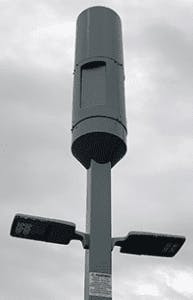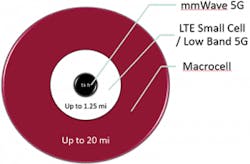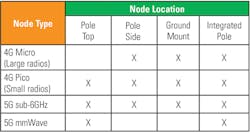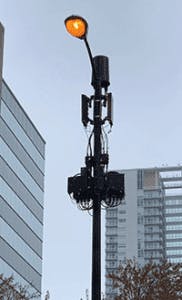Latest from 5G/6G & Fixed Wireless Access/Mobile Evolution
007 Solutions for Meeting Stealth Municipality Requirements —
Small Cell densification has been occurring in some form or fashion in the US for more than 6 years. Early small cells resembled a small macro site you would expect to see at the bottom of a 150-foot cell tower, complete with rack mount electronics and battery enclosures. Thankfully, back then small cell nodes were few and far between compared to today and what is expected in the near future. As time went on, wireless carriers moved to dark fiber for small cells, and abandoned the need for battery backup at these nodes as they primarily existed for extra capacity and not coverage. This, along with the evolution of physically smaller sized radios, makes for small cells that better lend themselves to blending into the urban landscape.
The Mission
Despite the trend of small cell nodes requiring smaller footprints, gaining municipality approval for these nodes is still often difficult. Even if you are able to come up with a node design that meets municipality requirements, there remain the obstacles of fees and permit approval time. Wireless carriers did receive some assistance from the FCC in early 2019 when the agency passed the Small Cell Order 18-133. This order instituted caps on permit times and fees that could be charged per node. The goal of this order was to streamline Small Cell deployment and pave the way for 5G. Multiple municipalities have challenged this order, but the order was upheld as recently as August, 2020 by a U.S. Court of Appeals decision.
4G and 5G small cell nodes can look vastly different and require different deployment strategies.
• 4G Small cells often use large macro tower radios (Micro) at full or reduced power to cover more area.
• They can also use much smaller and lower power small cell radios (Pico) to reduce the node size and coverage area.
Figure 1. Pole Top 4G/5G Concealment Shroud
Most Wireless carriers are using a mix of these to build out their networks. These 4G nodes typically rely on a canister style antenna near the top of the pole for signal transmission. Low and mid-band 5G (sub-6 GHz) would also be deployed in the same manner. (See Figure 1.)
When most people talk about 5G, what they are really referring to is the mmWave spectrum being deployed here in the US. The mmWave spectrum range offers the best of what 5G promises: low latency, incredible speed, and very large bandwidth.
The tradeoff to this is that the mmWave signals do not travel relatively far and do not travel well through obstacles. This means mmWave is really only a practical solution for very densely populated areas and will require five to ten times the number of nodes to cover the same area as 4G.
The mmWave radios required to support these nodes have integrated panel antennas which makes mmWave small cell nodes the smallest of all Small Cell nodes.
The remainder of the world will be covered by 5G with sub-6 GHz spectrum. These nodes cover a significantly larger area, akin to what 4G covers now, but at reduced speed and bandwidth as compared to mmWave. (See Figure 2.)
Figure 2. Theoretical Wireless Node Coverage Area
The appearance of extra equipment in, on, or around, streetlight/utility poles is subjective, to say the least. Whereas electric utilities have the right to place transformers wherever they are needed, the wireless carriers do not enjoy this luxury for their small cell nodes.
Sometimes restrictions can be quantitative, such as defining a maximum size or volume.
• Experience has shown that these restrictions are oftentimes not based on real-world knowledge of what type of equipment is needed to be deployed today or in the future. This can make it difficult to fit a small cell node into an arbitrary physical size restriction.
• Other times the restrictions are purely related to aesthetics. These are the more difficult restrictions to overcome.
InvisiLight® Solution for Deploying Fiber
April 2, 2022Go to Market Faster. Speed up Network Deployment
April 2, 2022Episode 10: Fiber Optic Closure Specs Explained…
April 1, 2022Food for Thought from Our 2022 ICT Visionaries
April 1, 2022In this case, a good approach to approval is to bring multiple options to the municipality Authority Having Jurisdiction (AHJ). Rather than saying No to a single option, the AHJ is given the ability to choose the best solution from a set of different solutions. Either way, the short answer to small cell deployments is there is no one-size-fits-all approach.
Some of the municipality pushback on size and aesthetics is due in part to the sheer number of small cell nodes that have gone up or will be going up over the next several years.
• The Small Cell Forum (SCF) (https://www.smallcellforum.org) forecasts the worldwide Small Cell market will continue to grow at a compound annual growth rate of 13% through 2027.
• Even though much of the buzz these days is focused on 5G, SCF also forecasts that 5G small cells will not outpace 4G nodes until early 2024.
This means wireless carriers will necessarily continue to deploy 4G, 5G, and combination 4G/5G, small cell nodes for the next several years.
Super-Secret Solutions
One of the ways to help with small cell aesthetics is to utilize some form of concealment to help the node blend with the environment in which it is being deployed. Depending on the node type, they can be deployed on top of the pole, on the side of the pole, on the ground, or even inside an integrated pole.
The challenges here are the number of different configurations and types of small cell nodes being deployed in different areas of the country along with the multiple different restrictions as mentioned above. This leads to a need to have multiple sizes and configurations of each type of solution to be able to satisfy the majority of node requirements that currently exist. (See Figure 3.)
Figure 3. Small Cell Deployment Locations by Node Type
Pole top concealment shrouds are well suited to 4G nodes with Pico, 5G mmWave nodes, and a combination of these 4G / 5G nodes. As seen in Figures 4 and 5, using concealment can greatly add to the overall aesthetic appeal of a node.
• Figure 4 is a combination 4G / 5G mmWave node with no concealment.
Figure 4. Unconcealed 4G/5G Small Cell Node
• Figure 5 is the same type of node but uses a pole top concealment shroud to hide cabling and give more of an overall streamlined appearance.
Figure 5. 4G/5G Node with Concealment Shroud
To accommodate the multiple different node configurations that exist, manufacturers like Charles Industries offer versions of this shroud for 4G only, 5G mmWave only, and the 4G/5G combination as shown here, as well as unique versions to fit the many different OEM radio models.
Pole Side Concealment Shrouds are a great solution for 4G Micro nodes, sub-6 GHz 5G nodes, or Neutral Host type nodes co-locating multiple carriers at a single pole location.
• The radios and ancillary equipment are placed in the shroud and the antenna is separate near the top of the pole.
•These also work well for Pico 4G nodes where local restrictions prohibit pole top solutions.
•However, these shrouds do not work well for mmWave nodes as those radios have integrated antennas, and need to be near the top of the pole for optimal RF coverage.
•These shrouds must also be available in multiple sizes depending on the equipment being installed and any local size restrictions.
•They can house ancillary equipment in addition to the radios needed for a small cell site: including power supplies for the radios, diplexers/combiners, fiber termination, and AC power distribution.
•The limit of what can fit in these shrouds is determined by the size chosen for a particular deployment.
Ground Mount Concealment Shrouds are a great option for areas where pole attachments are limited.
• They can house all the same equipment as the pole side concealment shroud, with the addition of a utility meter socket.
• These types of shrouds are better suited to the Micro-type radios as the distance from the radios to the antenna would limit transmission power with the Pico-type radios.
• While installation and maintenance are generally much easier with ground mount shrouds, many municipalities frown upon adding any type of ground furniture installations, as they may clutter pedestrian walkways and are prone to damage from accidental collisions by vehicles.
The last solution for concealing both 4G and 5G nodes is an Integrated Pole where the radios and ancillary equipment go partially or completely inside the diameter of the hollow pole or inside a cabinet built into the base of the pole.
• These deployments can be very streamlined as the end result looks only like a slightly larger light pole.
• The diameter of these poles is a factor of the size of the radios being installed within them.
• If using Pico-type radios, the integrated pole can be similar in size to existing light poles.
• If Micro-type radios are being used, the diameter of the integrated pole becomes larger, and can get to a point where it no longer fits the aesthetics of existing light poles. These larger poles also require a larger foundation which is not always possible in dense urban areas.
Mission Accomplished
Small cell densification is necessary to bring next-level communication to the world, including 5G, edge compute, and other emerging bandwidth intensive technologies. Deploying a robust Small Cell network is a balancing act of bringing wireless capacity to where it is needed while managing municipality constituents’ requirements on what this Small Cell network can look like in their urban landscape. Good aesthetics create community appeal and foster acceptance of carriers’ next-generation networks. Concealment is the best way to further this goal, and multiple types of concealment solutions are available, each having a place depending on Small Cell node type and location.
Like this Article?
Subscribe to ISE magazine and start receiving your FREE monthly copy today!














